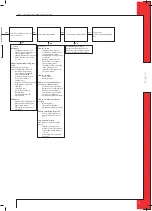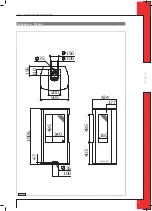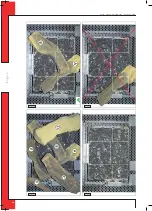
English
T R I O
-
I N S T R U C T I O N
F O R
I N S TA L L AT I O N
Start
2.01 Can pilot be lit?
2.03 Only one spark?
2.02 Sparking?
2.09 Ignition procedure
-
Oval knob on gas control is
on “MAN”. Set to “ON” and
restart.
Retarded ignition of main
burner(s)
Gas to main burner opens ca. 3-5
seconds after servo motor,
operating the gas valve, starts
running (sound of motor!). After
this the main burner is to ignite (at
least partially) within 10 seconds
and not with a firm noise WHOOF.
If not: no or delayed cross lighting
of main burner.
Hazardous situation.
Stop ignition procedure straight
away and first check for:
-
Position of logs or pebbles.
-
Burner holes (locally)
blocked.
Remove vermiculite dust.
-
Vermiculite missing.
-
Chips on burner.
-
Vermiculite not distributed
evenly across burner(s).
2.11 No proper cross lighting
of main burner(s).
-
Go to box 2.09 and take
actions act as described
for ‘retarded ignition of
main burner’.
2.06 Pilot can be lit.
Does it stay alight?
2.10 Do(es) main burner(s)
ignite smoothly and across
its/their full length after first
ignition by pilot burner?
2.08 Does main burner ignite
immediately?
2.04 Check:
Receiver
-
Replace missing, weak or
rechargeable batteries (not
enough power to open
thermoelectric valve).
Presence of gas on pilot burner
Check pilot on presence of gas at
normal ignition cycle or in Manual
Mode (turn oval knob on gas control
to MAN and keep safety shut off
valve opened with a screwdriver) and
ignite pilot with a lighter.
-
Pilot flame not on: Step 1.
-
Pilot flame on: Step 2.
Step 1: Pilot has no gas
Check:
-
Gas tap open?
-
Gas at gas control (line
pressure at measuring point on
gas control).
-
Gas flowing out of gas control?
(by loosening pilot tube at gas
control).
If not: check adjustment screw
pilot flame (under black cover):
sealing not to be broken.
Sealing broken: screw should
be fully open.
-
Blocking of pilot tube (kink or
dirt).
-
If this does not help: replace
gas control.
Step 2: Pilot has gas, but no
ignition
-
Electrode with 90° bended tip:
bend tip 1 mm higher.
-
Spark too weak (thin and
reddish).
Act as if ‘no spark’ in box 2.05
and perform actions described
for ignition cable and ignition
electrode.
-
Pilot flame too weak (dirty).
Remove injector (remove
gland nut and the pilot tube).
See that it does not fall away.
Clean with compressed air.
Rectify. Retry.
2.05 Check:
Ignition cable
-
Present and connected.
-
Being free from metal parts or
concrete.
-
Too long: cut away all
excessive length at receiver
end, and reconnect.
-
Shorting out to earth: replace
ignition cable.
-
Spark in wrong position:
- slide rubber sleeve on
ignition cable over ceramic of
electrode.
-
Replace electrode if
neccessary.
Ignition electrode
-
Straight electrode:
- oxidation (roughen electrode
with file or sand paper);
- position (4 mm from pilot
burner).
-
Cracks in ceramic (not always
visible): replace electrode.
Starting procedure
After switching off/going out the
remote is locked for 120 sec. (older
versions 60 sec).
Wait 2 minutes before reigniting..
2.07
Pilot out when servomotor
starts
to run? Check the thermocouple
system.
-
Measure thermocouple
voltage in mV just after
servomotor starts to run and
the voltage goes down.
-
Measure between red dot on
receiver and earth point on
gas control (see Appendix 4,
Fig. 25).
- 0 mV
- 2-3 mV
- 3-5 mV
- 6 mV and higher
-
Requirement: after
rectification actions
thermocouple voltage should
be 6 mV at least, just after
motor starts running!
Voltage 0 mV
-
Thermocouple defective.
Check by replacing or
measuring voltage at end
whilst heating (tip: with a
lighter).
-
Short circuiting or
interruptions in circuit:
Check:
- thermocouple tight in
interruptor;
- interruptor tight in gas
control;
- black wires (yellow/red end)
connected to inter
receiver;
- interruptor (mount
thermocouple directly in gas
control and ignite in Manual
Mode (see 2.04).
If pilot stays on: interruptor
defective.
Voltage 2-3 mV
-
Check pilot flame.
Too small:
- pilot dirty.
Clean up (see 2.04).
- check for pilot gas tube
tightness;
- pilot tube kinks or dirt inside;
- line pressure too low.
-
Tip: thermo couple not in
(correct!) pilot flame.
Bend into flame.
Voltage 3-5 mV
-
Appliance may work, but is
too critical.
Perform actions as described
for 2-3 mV.
Voltage 6 mV and higher
Voltage OK, so different cause.
-
Receiver defective. Check by
dismounting black-red and
yellow control cables from
receiver and link together.
Ignite fire in Manual Mode
(see 2.04). Pilot stays on:
receiver defective.
-
Gas control defective if
receiver is not defective.
Replace gas control.
yes
no
yes
yes
no
no
no
no
no
Fires with electronic ignition, fault finding: Ignition and burning
2.03a
-
Loosen and retighten
earthing screw on gas
control.
-
If this does not work:
replace receiver.
yes
yes
yes
16
Summary of Contents for Trio RCE G20
Page 23: ...E n g l i s h TRIO INSTRUCTION FOR INSTALLATION Fig 8 Fig 9 Fig 10 Fig 7 23...
Page 24: ...E n g l i s h TRIO INSTRUCTION FOR INSTALLATION Fig 11 Fig 13 Fig 12 Fig 14 24...
Page 25: ...E n g l i s h TRIO INSTRUCTION FOR INSTALLATION Fig 19 Fig 15 Fig 17 Fig 16 Fig 18 25...
Page 26: ...E n g l i s h TRIO INSTRUCTION FOR INSTALLATION Fig 21 Fig 20 26...
Page 28: ...DRU Verwarming B V The Netherlands Postbus 1021 NL 6920 BA Duiven Ratio 8 NL 6921 RW Duiven...













































